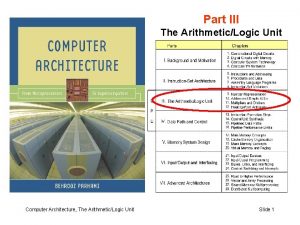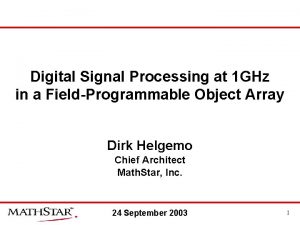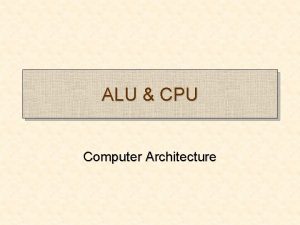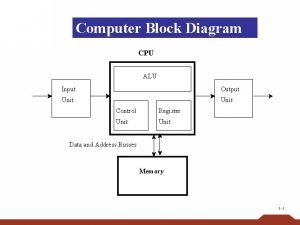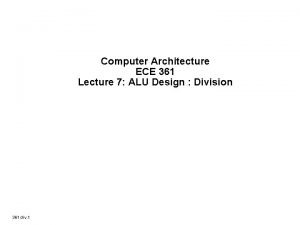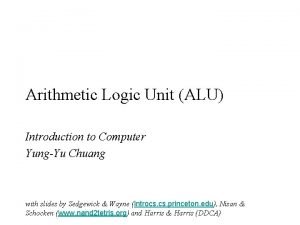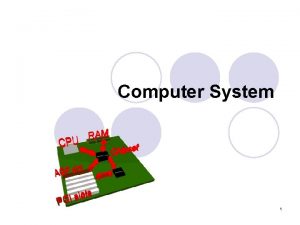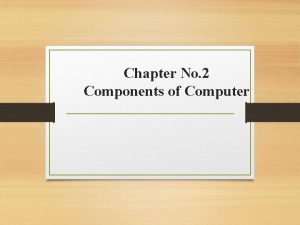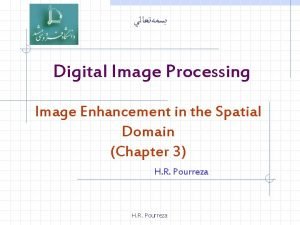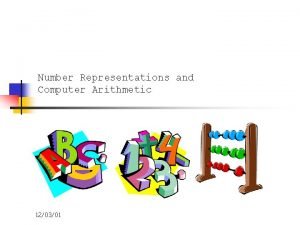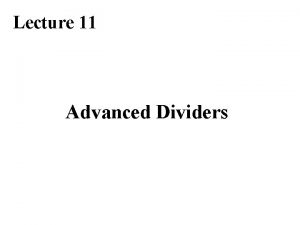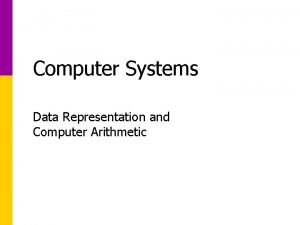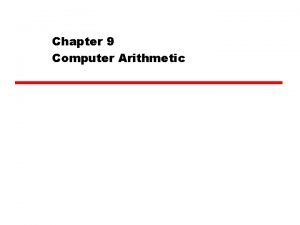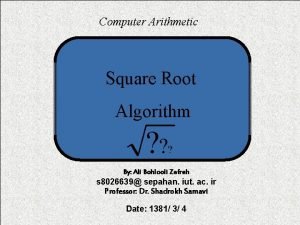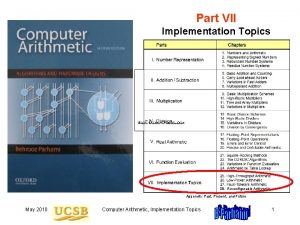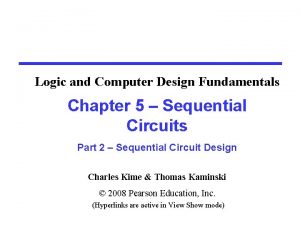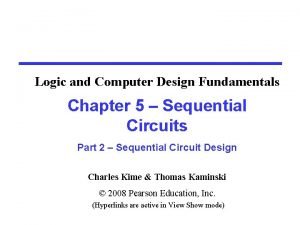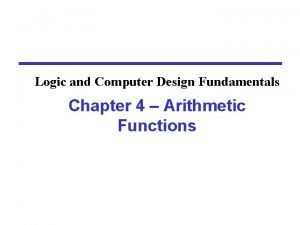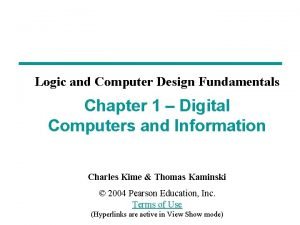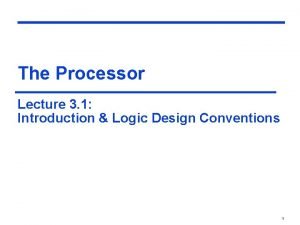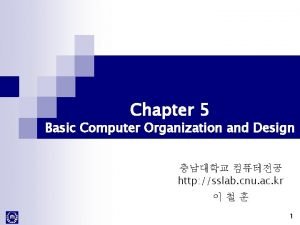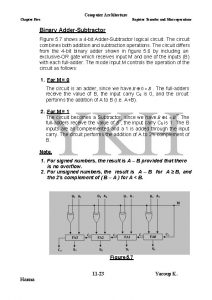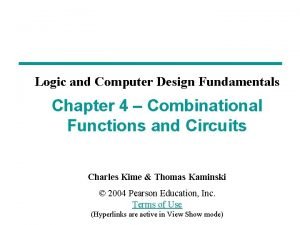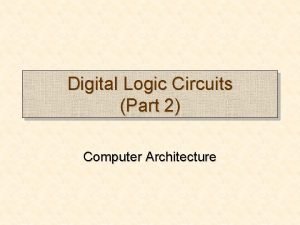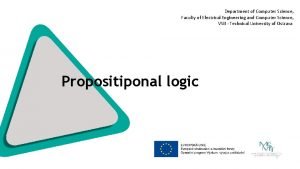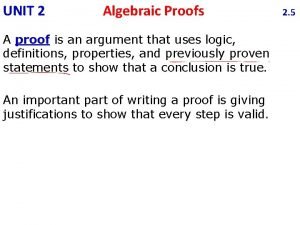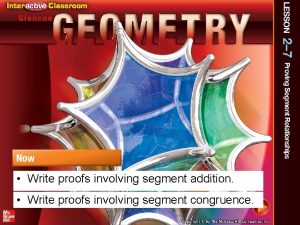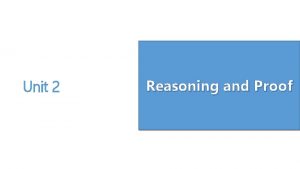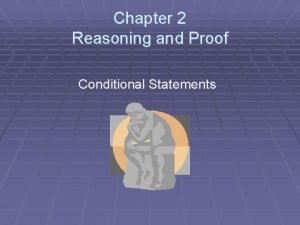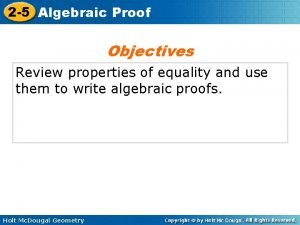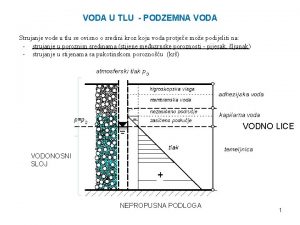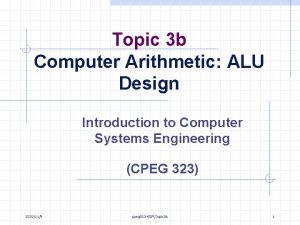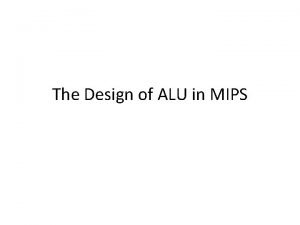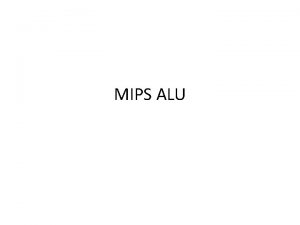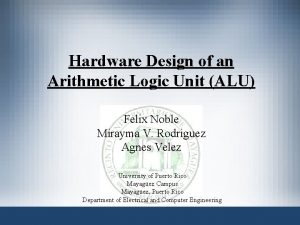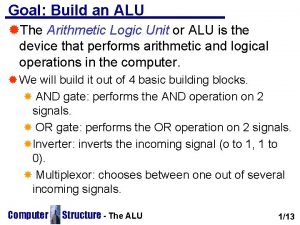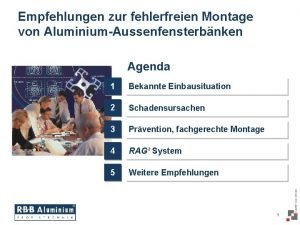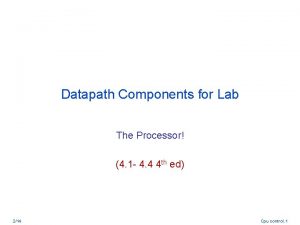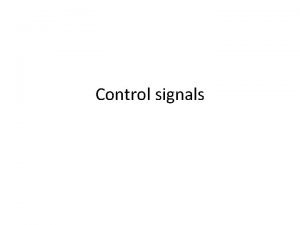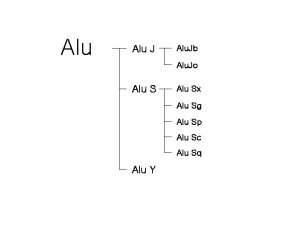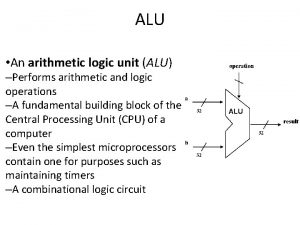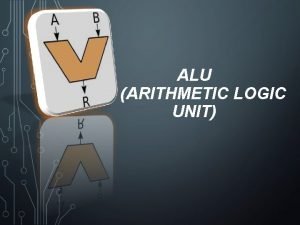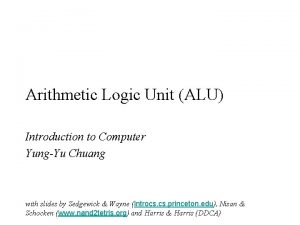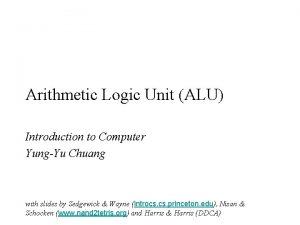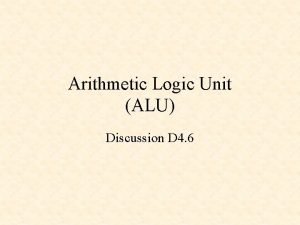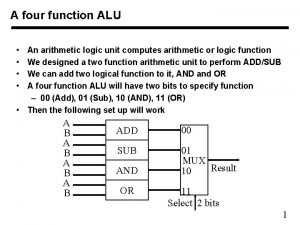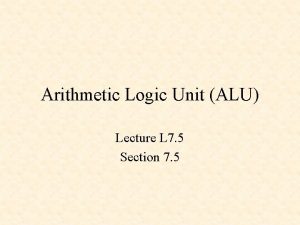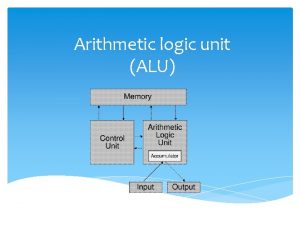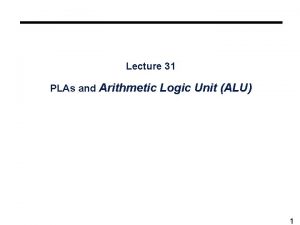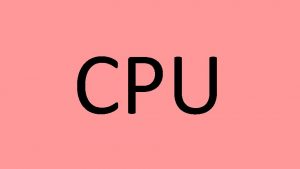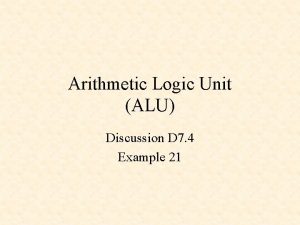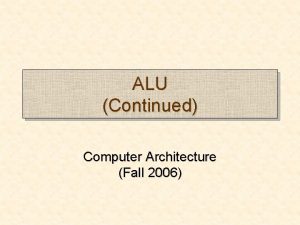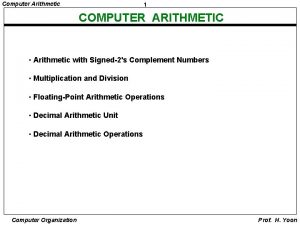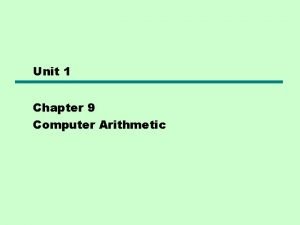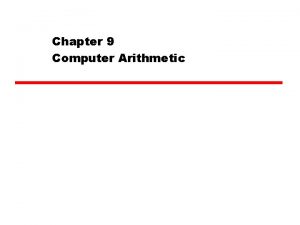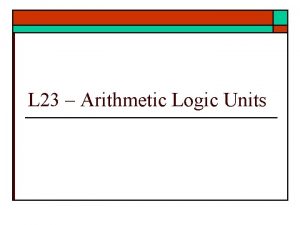Chapter 10 Computer Arithmetic Arithmetic Logic Unit ALU























































- Slides: 55


+ Chapter 10 Computer Arithmetic

+ Arithmetic & Logic Unit (ALU) n Part of the computer that actually performs arithmetic and logical operations on data n All of the other elements of the computer system are there mainly to bring data into the ALU for it to process and then to take the results back out n Based on the use of simple digital logic devices that can store binary digits and perform simple Boolean logic operations

ALU Inputs and Outputs

+ Integer Representation n In the binary number system arbitrary numbers can be represented with: n The digits zero and one n The minus sign (for negative numbers) n The period, or radix point (for numbers with a fractional component) n For purposes of computer storage and processing we do not have the benefit of special symbols for the minus sign and radix point n Only binary digits (0, 1) may be used to represent numbers

Sign-Magnitude Representation There are several alternative conventions used to represent negative as well as positive integers • All of these alternatives involve treating the most significant (leftmost) bit in the word as a sign bit • If the sign bit is 0 the number is positive • If the sign bit is 1 the number is negative Sign-magnitude representation is the simplest form that employs a sign bit Drawbacks: Because of these drawbacks, sign-magnitude representation is rarely used in implementing the integer portion of the ALU • Addition and subtraction require a consideration of both the signs of the numbers and their relative magnitudes to carry out the required operation • There are two representations of 0

+ Twos Complement Representation n Uses the most significant bit as a sign bit n Differs from sign-magnitude representation in the way that the other bits are interpreted Table 10. 1 Characteristics of Twos Complement Representation and Arithmetic

Table 10. 2 Alternative Representations for 4 -Bit Integers

+ Range Extension n Range of numbers that can be expressed is extended by increasing the bit length n In sign-magnitude notation this is accomplished by moving the sign bit to the new leftmost position and fill in with zeros n This procedure will not work for twos complement negative integers n Rule is to move the sign bit to the new leftmost position and fill in with copies of the sign bit n For positive numbers, fill in with zeros, and for negative numbers, fill in with ones n This is called sign extension

Fixed-Point Representation The radix point (binary point) is fixed and assumed to be to the right of the rightmost digit Programmer can use the same representation for binary fractions by scaling the numbers so that the binary point is implicitly positioned at some other location

+ Negation n Twos complement operation n Take the Boolean complement of each bit of the integer (including the sign bit) n Treating the result as an unsigned binary integer, add 1 +18 = 00010010 (twos complement) bitwise complement = 11101101 + 1 1110 = -18 n The negative of that number is itself: -18 = 1110 (twos complement) bitwise complement = 0001 + 1 00010010 = +18

+ Negation Special Case 1 0 = 0000 Bitwise complement = 1111 Add 1 to LSB 1 + Result 10000 Overflow is ignored, so: -0=0 (twos complement)

+ Negation Special Case 2 -128 Bitwise complement = Add 1 to LSB + Result = 10000000 01111111 1 10000000 So: -(-128) = -128 X Monitor MSB (sign bit) It should change during negation (twos complement)

Addition

Overflow OVERFLOW RULE: + If two numbers are added, and they are both positive or both negative, then overflow occurs if and only if the result has the opposite sign. Rule

Subtraction SUBTRACTION RULE: + To subtract one number (subtrahend) from another (minuend), take the twos complement (negation) of the subtrahend add it to the minuend. Rule

Subtraction

Geometric Depiction of Twos Complement Integers

Hardware for Addition and Subtraction

Multiplication

+ Hardware Implementation of Unsigned Binary Multiplication

+ Flowchart for Unsigned Binary Multiplication

+ Twos Complement Multiplication

+ Comparison

Booth’s Algorithm +

Example of Booth’s Algorithm

Examples Using Booth’s Algorithm

Division

+ Flowchart for Unsigned Binary Division

+ Example of Restoring Twos Complement Division

+ Floating-Point Representation Principles n With a fixed-point notation it is possible to represent a range of positive and negative integers centered on or near 0 n By assuming a fixed binary or radix point, this format allows the representation of numbers with a fractional component as well n Limitations: n Very large numbers cannot be represented nor can very small fractions n The fractional part of the quotient in a division of two large numbers could be lost

Typical 32 -Bit Floating-Point Format

+ Floating-Point Significand n The final portion of the word n Any floating-point number can be expressed in many ways The following are equivalent, where the significand is expressed in binary form: 0. 110 * 25 110 * 22 0. 0110 * 26 n Normal number n The most significant digit of the significand is nonzero

+ Expressible Numbers

+ Density of Floating-Point Numbers

IEEE Standard 754 Most important floating-point representation is defined Standard was developed to facilitate the portability of programs from one processor to another and to encourage the development of sophisticated, numerically oriented programs Standard has been widely adopted and is used on virtually all contemporary processors and arithmetic coprocessors IEEE 754 -2008 covers both binary and decimal floatingpoint representations

+ IEEE 754 -2008 n Defines the following different types of floating-point formats: n Arithmetic format n n Basic format n n All the mandatory operations defined by the standard are supported by the format. The format may be used to represent floating-point operands or results for the operations described in the standard. This format covers five floating-point representations, three binary and two decimal, whose encodings are specified by the standard, and which can be used for arithmetic. At least one of the basic formats is implemented in any conforming implementation. Interchange format n A fully specified, fixed-length binary encoding that allows data interchange between different platforms and that can be used for storage.

IEEE 754 Formats

Table 10. 3 IEEE 754 Format Parameters * not including implied bit and not including sign bit

+ Additional Formats Extended Precision Formats n Provide additional bits in the exponent (extended range) and in the significand (extended precision) n Lessens the chance of a final result that has been contaminated by excessive roundoff error n Lessens the chance of an intermediate overflow aborting a computation whose final result would have been representable in a basic format n Affords some of the benefits of a larger basic format without incurring the time penalty usually associated with higher precision Extendable Precision Format n Precision and range are defined under user control n May be used for intermediate calculations but the standard places no constraint or format or length

Table 10. 4 IEEE Formats

Interpretation of IEEE 754 Floating-Point Numbers (a) binary 32 format Table 10. 5 Interpretation of IEEE 754 Floating-Point Numbers (page 1 of 3)

Interpretation of IEEE 754 Floating-Point Numbers (b) binary 64 format Table 10. 5 Interpretation of IEEE 754 Floating-Point Numbers (page 2 of 3)

Interpretation of IEEE 754 Floating-Point Numbers (c) binary 128 format Table 10. 5 Interpretation of IEEE 754 Floating-Point Numbers (page 3 of 3)

Table 10. 6 Floating-Point Numbers and Arithmetic Operations

Floating-Point Addition and Subtraction

+ Floating-Point Multiplication

+ Floating-Point Division

+ Precision Considerations Guard Bits

+ Precision Considerations Rounding n IEEE standard approaches: n Round n The result is rounded to the nearest representable number. n Round n toward -∞: The result is rounded down toward negative infinity. n Round n toward +∞: The result is rounded up toward plus infinity. n Round n to nearest: toward 0: The result is rounded toward zero.

+ Interval Arithmetic n Provides an efficient method for monitoring and controlling errors in floating-point computations by producing two values for each result n The two values correspond to the lower and upper endpoints of an interval that contains the true result n n n The width of the interval indicates the accuracy of the result If the endpoints are not representable then the interval endpoints are rounded down and up respectively If the range between the upper and lower bounds is sufficiently narrow then a sufficiently accurate result has been obtained n Minus infinity and rounding to plus are useful in implementing interval arithmetic Truncation n Round toward zero n Extra bits are ignored n Simplest technique n A consistent bias toward zero in the operation n Serious bias because it affects every operation for which there are nonzero extra bits

+ IEEE Standard for Binary Floating-Point Arithmetic Infinity Is treated as the limiting case of real arithmetic, with the infinity values given the following interpretation: - ∞ < (every finite number) < + ∞ For example: 5 + (+ ∞ ) = + ∞ 5÷ (+ ∞ ) = +0 5 - (+ ∞ ) = - ∞ (+ ∞ ) + (+ ∞ ) =+∞ 5 + (- ∞ ) = - ∞ (- ∞ ) + (- ∞) =-∞ 5 - (- ∞ ) =+∞ (- ∞ ) - (+ ∞ ) =-∞ 5 * (+ ∞ ) = + ∞ (+ ∞ ) - (- ∞ ) =+∞

+IEEE Standard for Binary Floating-Point Arithmetic Quiet and Signaling Na. Ns n Signaling Na. N signals an invalid operation exception whenever it appears as an operand n Quiet Na. N propagates through almost every arithmetic operation without signaling an exception Table 10. 7 Operations that Produce a Quiet Na. N

+IEEE Standard for Binary Floating-Point Arithmetic Subnormal Numbers

+ Summary Computer Arithmetic Chapter 10 n Integer arithmetic n ALU n Negation n Integer representation n Addition and subtraction n Multiplication n Division n Sign-magnitude representation Twos complement representation n Floating-point arithmetic n Range extension n Addition and subtraction n Fixed-point representation n Multiplication and division Floating-point representation n Precision consideration n IEEE standard for binary floating-point arithmetic n Principles n IEEE standard for binary floating-point representation
 Microinstruction example
Microinstruction example Arithmetic logic unit
Arithmetic logic unit Arithmetic logic unit
Arithmetic logic unit Design of alu in computer architecture
Design of alu in computer architecture And operation
And operation 64 bit alu
64 bit alu The complete hack alu truth table consists of
The complete hack alu truth table consists of Design of alu in computer architecture
Design of alu in computer architecture Cpu consists of
Cpu consists of Alu control
Alu control Subsections namely of alu
Subsections namely of alu The objective of sharpening spatial filter is to
The objective of sharpening spatial filter is to First order logic vs propositional logic
First order logic vs propositional logic First order logic vs propositional logic
First order logic vs propositional logic Third order logic
Third order logic Concurrent vs sequential
Concurrent vs sequential Tw
Tw 캠블리 단점
캠블리 단점 Is it x y or y x
Is it x y or y x Combinational logic sequential logic 차이
Combinational logic sequential logic 차이 Logic chapter three
Logic chapter three Unit 6 review questions
Unit 6 review questions Fftooo
Fftooo Computer arithmetic
Computer arithmetic Behrooz parhami computer arithmetic
Behrooz parhami computer arithmetic Data representation and computer arithmetic
Data representation and computer arithmetic 10000000/215
10000000/215 Computer arithmetic
Computer arithmetic William stallings computer organization and architecture
William stallings computer organization and architecture Computer arithmetic
Computer arithmetic Jk flip flop
Jk flip flop Logic and computer design fundamentals
Logic and computer design fundamentals 010000112
010000112 Logic and computer design fundamentals
Logic and computer design fundamentals Processor logic design
Processor logic design Basic computer design
Basic computer design Shift microoperations in computer architecture
Shift microoperations in computer architecture Logic & computer design fundamentals
Logic & computer design fundamentals Digital logic and computer architecture
Digital logic and computer architecture Computer logic
Computer logic Input layer
Input layer Unit 2 logic and proof homework 1
Unit 2 logic and proof homework 1 Geometry basics segment addition postulate
Geometry basics segment addition postulate Chapter 2 reasoning and proof answer key
Chapter 2 reasoning and proof answer key Proving conditional statements
Proving conditional statements 2-5 algebraic proof
2-5 algebraic proof Voda u tlu
Voda u tlu Alu operations
Alu operations Alu mips
Alu mips Set less than alu
Set less than alu Fungsi dari input output port adalah
Fungsi dari input output port adalah Alu hardware
Alu hardware Alu operations
Alu operations Alu fensterbank bochum
Alu fensterbank bochum 32 bit alu verilog
32 bit alu verilog Alu control truth table
Alu control truth table

